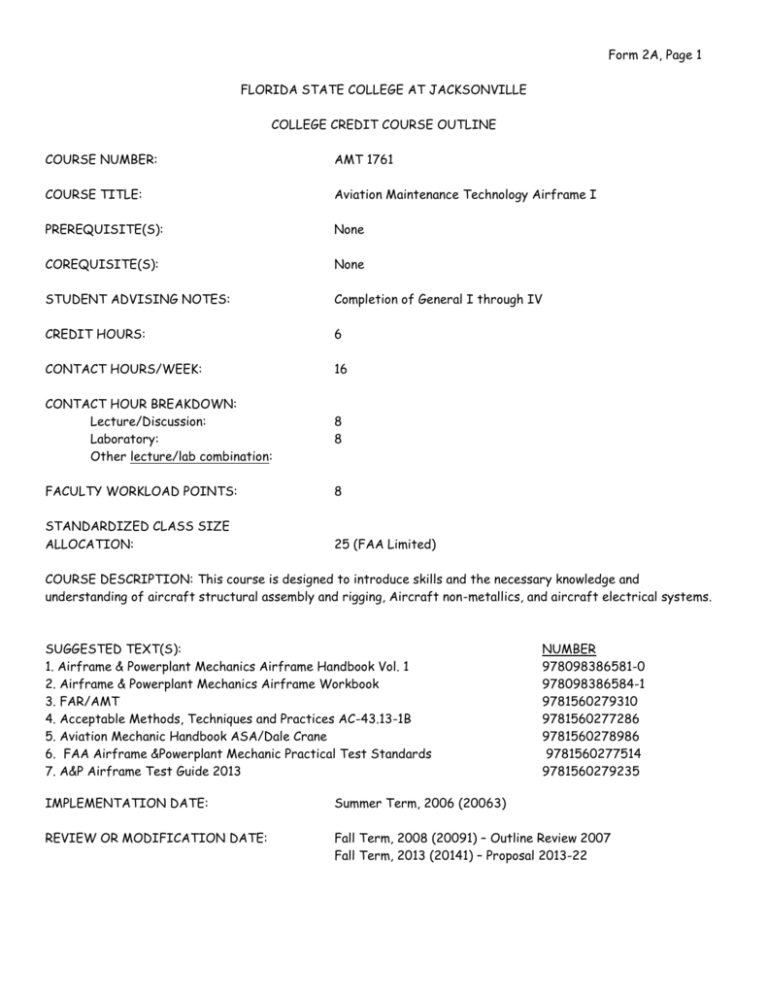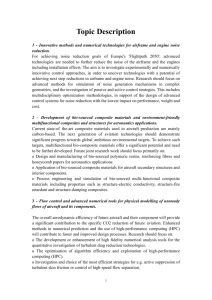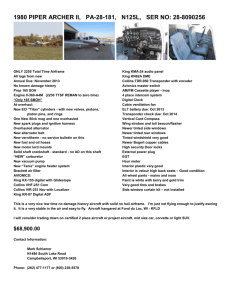AMT 1761 - Curriculum Services
advertisement

Form 2A, Page 1 FLORIDA STATE COLLEGE AT JACKSONVILLE COLLEGE CREDIT COURSE OUTLINE COURSE NUMBER: AMT 1761 COURSE TITLE: Aviation Maintenance Technology Airframe I PREREQUISITE(S): None COREQUISITE(S): None STUDENT ADVISING NOTES: Completion of General I through IV CREDIT HOURS: 6 CONTACT HOURS/WEEK: 16 CONTACT HOUR BREAKDOWN: Lecture/Discussion: Laboratory: Other lecture/lab combination: 8 8 FACULTY WORKLOAD POINTS: 8 STANDARDIZED CLASS SIZE ALLOCATION: 25 (FAA Limited) COURSE DESCRIPTION: This course is designed to introduce skills and the necessary knowledge and understanding of aircraft structural assembly and rigging, Aircraft non-metallics, and aircraft electrical systems. SUGGESTED TEXT(S): 1. Airframe & Powerplant Mechanics Airframe Handbook Vol. 1 2. Airframe & Powerplant Mechanics Airframe Workbook 3. FAR/AMT 4. Acceptable Methods, Techniques and Practices AC-43.13-1B 5. Aviation Mechanic Handbook ASA/Dale Crane 6. FAA Airframe &Powerplant Mechanic Practical Test Standards 7. A&P Airframe Test Guide 2013 NUMBER 978098386581-0 978098386584-1 9781560279310 9781560277286 9781560278986 9781560277514 9781560279235 IMPLEMENTATION DATE: Summer Term, 2006 (20063) REVIEW OR MODIFICATION DATE: Fall Term, 2008 (20091) – Outline Review 2007 Fall Term, 2013 (20141) – Proposal 2013-22 Form 2A, Page 2 COURSE TOPICS Note: § Denotes required project I. AIRCRAFT STRUCTURAL ASSEMBLY AND RIGGING CONTACT HOURS PER TOPIC 60 A. Airframes Safety Objectives: 1. Discuss general safety practices. 2. Identify safety precautions related to Airframes 3. Discuss MSDS related to Airframes. B. Fuselage Construction Objectives: 1. Discuss the evolution of aircraft structures. 2. Discuss types of fuselage construction and materials used. 3. Compare and contrast monocoque and semi-monocoque fuselage construction and usage. 4. Identify and describe usage of truss type fuselage. 5. Identify structural members 6. Discuss types of doors and windows on aircraft. 7. Discuss interior furnishings 8. § Inspect , check, service and repair windows, doors and interior furnishings (Level 2) (App. C.I, d.13) (AF1-006) C. Wing Construction Objectives: 1. Identify semi-cantilever wing construction. 2. Identify cantilever construction. 3. Discuss wood and metal construction. 4. Identify wing structural members D. Empennage Objectives: 1. Identify empennage components. 2. Describe stability surfaces. 3. Describe control surfaces. E. Introduction to Rotary-Wing Aircraft Objectives: 1. Discuss the history of rotary wings. 2. Explain the fundamentals and configurations of rotary-wing aircraft. 3. Differentiate between types of rotorcraft. 4. Discuss advantages and disadvantages of an autogiro. Form 2A, Page 3 COURSE TOPICS (continued) Note: § Denotes required project F. CONTACT HOURS PER TOPIC Engine Mounts Objectives: 1. Discuss the design and characteristics of piston-style engine mounts. 2. Discuss the design and characteristics of jet-style engine mounts. 3. Describe the purpose and construction of the firewall. G. Landing Gear Objectives: 1. Identify types (configurations) of landing gear. 2. Discuss landing gear classifications. H. Basic Aerodynamics Objectives: 1. List properties of the atmosphere that affect aircraft control and performance. 2. Discuss principles of physics that apply to flight and aerodynamics. I. High Speed Aerodynamics Objectives: 1. Discuss high-speed subsonic flight. 2. Define transonic flight. 3. Describe supersonic and hypersonic flight. J. Flight Forces Objectives: 1. List and define the four flight forces. 2. Discuss the relationship between lift and gravity (weight). 3. Discuss the relationship between thrust and drag. 4. Compare types of drag on an aircraft. K. Axes of an Aircraft, Stability and Control Objectives: 1. List the three axes of an aircraft. 2. Describe longitudinal stability and control. 3. Describe lateral stability and control. 4. Describe vertical stability and control. Form 2A, Page 4 COURSE TOPICS (continued) Note: § Denotes required project CONTACT HOURS PER TOPIC L. Secondary and Auxiliary Controls Objectives: 1. Discuss the design and function of each of the following types of tabs: trim, balance, servo, anti-servo, and spring. 2. Explain the function of various high lift devices on the wing's trailing edge: plain, split, slotted, Fowler, and slotted-Fowler flaps. 3. Describe the purpose of high lift devices on the wing's leading edge: slots, slats, leading edge flaps, stall strips, vortex generators, special wing tips, etc. M. Control Cable Systems and Equipment Objectives: 1. Identify types and usages of aircraft control cables. 2. Describe various means of attachment of aircraft control cables. 3. § Fabricate a control cable using the Nicopress and swaged terminal method. (Level 3) (App. C.I, f. 25) (AF1-007) 4. Discuss the usage of pulleys and problems caused by misuse. 5. Describe the function of fairleads. 6. Discuss the usage of pressure seals. 7. Explain the function of bellcranks. 8. Describe the function of control horns. 9. Discuss the function of push-pull rods. 10. Discuss the usage and importance of a rigging chart. 11. Describe the purpose of a tensiometer. 12. Explain the usage of a protractor and contour plates. 13. § Demonstrate the turnbuckle lockwire technique. (Level 3) (App. C.I, f. 26) (AF1-008) N. Rigging Specifications Objectives: 1. Discuss the purpose and use of rigging specifications 2. § Locate rigging specifications for a helicopter and fixed wing aircraft. (Level 2) (App. C.I, f. 22,23) (AF1-009) Form 2A, Page 5 COURSE TOPICS (continued) Note: § Denotes required project O. CONTACT HOURS PER TOPIC Assembly and Rigging Procedures Objectives: 1. Explain the purpose and procedure for a symmetry check. 2. § Perform a structural alignment check. (Level 2) (App. C.I, f. 24) (AF1-010) 3. Discuss the purpose for and procedure used to set wing dihedral angles. 4. Explain the purpose for and procedure used to set wing incidence angle. 5. Describe the purpose and procedure for wing trammeling. 6. Discuss the purpose and procedure for checking fin verticality. 7. § Perform a fin verticality check. (Level 2) (App C.I, f. 24) (AF1-011) 8. § Remove, check balance, reinstall and adjust a primary control surface. (Level 3) (App. C.I, f. 23, 25,26) (AF1-012) 9. § Determine and list rigging requirements using a maintenance manual. (Level 2) (App. C.I, f. 22,23) (AF1-013) 10. § Rig a control system. (Level 3) (App. C.I, f. 23,26) (AF1-014) P. Helicopter Characteristics and Rigging Objectives: 1. Identify various types of helicopters 2. Compare and contrast rigid rotor, semi-rigid rotor, and fully articulated rotor design. 3. List and explain aerodynamic characteristics of rotor-wing aircraft. 4. Discuss causes and corrective measures for helicopter vibrations. (Level 1) (App. C.I, f. 22) 5. Discuss procedures for correcting helicopter vibrations. (Level 1) (App. C.I, f. 22) Q. Unit Test II. AIRCRAFT NON-METALLICS A. Safety Objectives: 1. Discuss safety precautions in working with non-metallics 2. Discuss the different chemicals used and their MSDS. B. Types of Non-Metallic Materials Objectives: 1. Discuss the purpose and use of non-metallic materials used in aircraft. 2. List the different non-metallic materials used in aircraft structures. 3. Discuss the different types of wood used in aircraft 4. Discuss the different types of plastics used 5. Define composite materials. 6. Discuss the different types of seal materials 60 Form 2A, Page 6 COURSE TOPICS (continued) Note: § Denotes required project CONTACT HOURS PER TOPIC C. Wood Inspection and Repairs Objectives: 1. Discuss inspection and defects of wood structures. (Level 1) (App. C.I, a. 2,3) 2. Discuss wood structural repairs 3. Differentiate between types of wood patches and their usage. (Level 1) (App. C.I, a. 1) 4. Identify and describe various wood repairs. (Level 1) (App. C.I, a. 1) D. Composite Materials Objectives: 1. Match terms related to bonded structures to their correct definitions. 2. Discuss usages and characteristics of reinforcing fibers. 3. Discuss usages and characteristics of matrix materials. 4. Discuss usages and characteristics of core materials. 5. Select true statements related to types and characteristics of bonded structures. E. Composite Manufacturing Objectives: 1. Discuss safety practices related to composite manufacturing/repair. 2. Discuss composite manufacturing/repair techniques. 3. Discuss the various methods of applying pressure during the curing process. 4. Discuss methods of, and various equipment used in, the curing process. 5. Discuss tools, equipment, and processes used in machining composites. 6. § Manufacture a foam core composite structure. (Level 3) (App. C.I, d.11) (AF1-025) 7. § Manufacture a honeycomb core composite structure. (Level 3) (App. C.I, d.11) (AF1-026). F. Composite Repairs Objectives: 1. Discuss classification and types of composite damage. 2. Discuss inspection and testing methods of primary and secondary composite structures. 3. § Inspect bonded honeycomb structure. (Level 2) (App. C.I, d.11) (AF1-027) 4. Discuss general composite repair operations and procedures. 5. Discuss causes for composite repair failures. 6. Discuss the importance of cleaning prior to repairs 7. Discuss typical composite repair procedures. 8. Discuss delaminations and their repairs. 9. Discuss damage and repairs to laminate structures. 10. Discuss damage and repairs to sandwich structures. 11. Discuss damage and repairs to honeycomb structures. 12. § Remove damage from bonded honeycomb with a router. (Level 3) (App. C.I, d. 12) (AF1-028) 13. § Perform core replacement and fiberglass, Kevlar or graphite overlay on bonded honeycomb. (Level 3) (App. C.I, b.5, d.12) (AF1-029) Form 2A, Page 7 COURSE TOPICS (continued) Note: § Denotes required project CONTACT HOURS PER TOPIC 14. Discuss selection, installation, and removal of special fasteners for metallic, bonded, and composite structures. 15. § Select, install and remove special fasteners for bonded and composite structures. (Level 2) (App. C.I, d.10) (AF1-030) G. Plastics Objectives: 1. Discuss characteristics of acrylic and cellulose acetate plastic material. 2. Discuss storage and handling of transparent plastics. 3. Discuss forming, sawing, drilling, and cementing transparent plastics. 4. Discuss repairing transparent plastics. 5. Discuss how to protect plastics during handling and repair operations. 6. § Repair surface scratches in transparent plastic laminates. (Level 2) (App. C.I, d. 12) (AF1-031) 7. § Repair a crack in plastic. (Level 2)(App. C.I, d. 12) (AF1-032) H. Unit Test III. AIRCRAFT ELECTRICAL 60 A. Safety and Terms Objectives: 1. List and practice safety precautions related to aircraft wiring, motors and generators. 2. Define terms related to aircraft wiring, electrical components, motors and generators. B. Aircraft Wiring Objectives: 1. Discuss types of wire and insulation. 2. Discuss wire size selection 3. Interpret and use a wire/cable size chart. C. Wiring Diagrams Objectives: 1. Discuss block diagrams. 2. Discuss pictorial diagrams. 3. Interpret schematic diagrams. 4. Discuss avionics circuits. 5. Describe landing gear circuits. 6. Explain the master switch circuit. Form 2A, Page 8 COURSE TOPICS (continued) Note: § Denotes required project CONTACT HOURS PER TOPIC D. Wiring Installations Objectives: 1. Identify aircraft wire markings. 2. Compare single and double wire installation 3 § Select proper wire for various applications. (Level 3) (App. C.II, g. 49) (AF1-038) 4. Determine proper wire grouping, bundles, and routing. 5. § Lace and tie wire bundles. (Level 3) (App. C.II, g. 49) (AF1-039) 6. § Install terminal ends and splices. (Level 3) (App. C.II, g. 48, 49, 50a) (AF1-040) 7. § Prepare and install frame ground. (Level 3) (App. C.II, g.49) (AF1-041) 8. Differentiate between conduit and shielding. 9. § Inspect and repair aircraft connector pins and sockets. (Level 2) (App. C.II, g. 48)(AF1-042) E. Circuit Protective Devices Objectives: 1. Identify aircraft fuses. 2. Identify aircraft circuit breakers. 3. § Interpret circuit protector charts. (Level 3) (App. C.II, g. 49) (AF1-043) F. Circuit Controls Objectives: 1. Discuss types and usage of switches. 2. § Interpret switch de-rating chart. (Level 3) (App. C.II, g. 49) (AF1-044) 3. Discuss switch installation. 4. Identify relay and solenoid construction, operation, and applications. 5. § Install and check airframe electrical wiring, controls, switches, indicators, and protective devices. (Level 3) (App. C.II, g. 49) (AF1-045) G. Soldering Objectives: 1. Discuss soldering safety. 2. Describe soldering practices, procedures, and techniques. 3. § Assemble components using approved soldering procedures.(Level 3) (C.II, g.49)(AF1-046) H. Electrical System Troubleshooting Objectives: 1. Discuss troubleshooting techniques. 2. Describe the installation of various electrical system components. 3. § Determine normal circuit operation using schematic diagrams, and equipment charts. (Level 3) (App. C.II, g. 50a) (AF1-047) 4. § Troubleshoot an airframe AC and DC electrical system for an open wire. (Level 3) (App. C.II, g. 50a) (AF1-048) Form 2A, Page 9 COURSE TOPICS (continued) Note: § Denotes required project CONTACT HOURS PER TOPIC I. Generator Theory Objectives: 1. Discuss magnetism in relation to electromechanical generation. 2. Identify generator parts and their functions. 3. Discuss the three types of generators and methods of control. 4. Discuss methods of controlling armature reactance. J. Basic Generator Inspection and Testing Objectives: 1. Discuss visual inspections of generator components. 2. Determine inspection procedures for armatures using a growler. 3. Explain inspection and testing procedures for field circuits. 4. Discuss procedures for correcting brush arcing. 5. § Disassemble, inspect, troubleshoot and reassemble a generator. (Level 2)(App. C.II, g. 50b) (AF1-049) K. 12-Volt Shunt-Wound Generator System Objectives: 1. Discuss the operation of a three-unit control panel. 2. Explain the installation and removal of an aircraft generator. 3. Discuss parallel DC charging systems. L. 24-Volt Compound-Wound Generator System Objectives: 1. Discuss the operation of a carbon pile voltage regulator. 2. Identify interpoles and series windings and discuss their usage. 3. Troubleshoot, inspect, and adjust a carbon pile voltage regulator. 4. Discuss the operation of differential reverse current relay. (DRCR) 5. Discuss generator paralleling circuits. M. 12/24 Volt Alternators Objectives: 1. Discuss alternator parts and their functions. 2. Compare generators and alternators. 3. Explain alternator controls. 4. Discuss alternator service and maintenance. 5. § Set up and test an alternator. (Level 3) (App. C.II, g. 50a) (AF1-050) Form 2A, Page 10 COURSE TOPICS (continued) Note: § Denotes required project CONTACT HOURS PER TOPIC N. 120/208 VAC Generators Objectives: 1. Discuss brush type AC generators and voltage regulation. 2. Discuss brushless AC generators and voltage regulation. 3. Describe the purpose and operation of constant and integrated speed drives. (Level 1) (App. C.II, g. 50b 4. O. Inverters and Rectifiers Objectives: 1. Explain rotary type inverters. 2. Discuss solid-state inverters. 3. Discuss methods of rectification. 4. Discuss transformer / rectifier units P. Power Distribution Objectives: 1. Discuss simple power systems. 2. Explain the difference between parallel and split bus systems. 3. Discuss bus tie systems (split bus). Q. Synchronous Servos Objectives: 1. Discuss stepper motors. 2. Discuss autosyn systems. 3. Explain synchronous systems. R. IV. Unit Test EMPLOYABILITY SKILLS FOR AIRFRAME MAINTENANCE TECHNICIAN 25 A. Conducting Job Search 1. Media and agency information sources. 2. Exploring websites, career development centers, publications, and resource documents. 3. Personal documents required when applying. B. Job Application 1. Application forms. 2. Resume writing. 3. Punctuation and spelling. Form 2A, Page 11 CONTACT HOURS PER TOPIC COURSE TOPICS (continued) Note: § Denotes required project C. Interview Skills 1. Types of interviews 2. Etiquette required. 3. Presentation skills. D. On the Job Behaviors 1. Response to criticism. 2. Work habits. 3. Interpersonal relationships. E. Job Changes 1. Promotions. 2. Inter-department. 3. New companies. F. Right-to-Know Law 1. Florida statutes. 2. Exceptions. V. AIRFRAME I REMEDIATION, REVIEW, AND TESTING Airframe Block I Final Exam 35 Form 2A, Page 12 PROGRAM TITLE: Aviation Maintenance Management COURSE TITLE: Aviation Maintenance Technology Airframe I CIP NUMBER: 1649010401 LIST PERFORMANCE STANDARD ADDRESSED: NUMBER(S): TITLES(S): 27.0 MAINTAIN WOOD STRUCTURES--The student will be able to: 27.01 Service and repair wood structures. 27.02 Identify wood defects. 27.03 Inspect wood structures. 32.0 PERFORM AIRFRAME ASSEMBLY AND RIGGING--The student will be able to: 32.01 Identify and utilize appropriate rigging tools and equipment. 32.02 Rig rotary-wing aircraft. 32.03 Rig fixed-wing aircraft. 32.04 Check alignment of structures. 32.05 Assemble aircraft. 32.06 Balance and rig movable structures. 32.07 Jack aircraft. 40.0 INSPECT AND REPAIR AIRCRAFT ELECTRICAL SYSTEMS--The student will be able to: 40.01 Identify and utilize appropriate electrical tools and equipment. 40.02 Repair aircraft electrical system components. 40.03 Remove, service and install electric indicators, protective devices, wiring and controls. 40.04 Inspect and repair AC and DC current electrical systems. 44.0 DEMONSTRATE KNOWLEDGE OF FAA AIRCRAFT MECHANIC LICENSING REQUIREMENTS--The student will be able to: 44.01 Successfully complete the FAA powerplant written, oral and practical examinations. 44.02 Display an FAA powerplant Mechanic’s certificate. 44.03 Successfully complete the FAA airframe written, oral and practical examinations. 44.04 Display an FAA airframe mechanic’s certificate. 49.0 DEMONSTRATE EMPLOYABILITY SKILLS--The student will be able to: 49.01 Conduct a job search. 49.02 Secure information about a job. 49.03 Identify documents which may be required when applying for a job interview. 49.04 Complete a job application form correctly. 49.05 Demonstrate competence in job interview techniques. 49.06 Identify or demonstrate appropriate responses to criticism from employer, supervisor or other employees. 49.07 Identify acceptable work habits. 49.08 Demonstrate knowledge of how to make appropriate job changes. 49.09 Demonstrate acceptable employee health and grooming habits. 49.10 Exhibit punctuality, initiative, courtesy, loyalty and honesty. 49.11 Demonstrate knowledge of the “Right-T0-Know Law” as recorded in 29 CFR-1910, 1200. Florida State College At Jacksonville Course Learning Outcomes & Assessment NOTE: Use either the Tab key or mouse click to move from field to field. The box will expand to accommodate your entry. Section 1 SEMESTER CREDIT HOURS (CC): 6 CONTACT HOURS (NCC): COURSE PREFIX AND NUMBER: AMT 1761 COURSE TITLE: Aviation Maintenance Technology Airframe 1 Section 2 TYPE OF COURSE: (Click on the box to check all that apply) AA Elective AS Required Professional Course College Prep AS Professional Elective AAS Required Professional Course Technical Certificate Other Apprenticeship PSAV General Education: (For General Education courses, you must also complete Section 3 and Section 8) Section 3 (If applicable) INDICATE BELOW THE DISCIPLINE AREA FOR GENERAL EDUCATION COURSES: Communications Social & Behavioral Sciences Natural Sciences Humanities Mathematics Section 4 INTELLECTUAL COMPETENCIES: Reading Speaking Critical Analysis Writing Listening Information Literacy Quantitative Skills Ethical Judgment Scientific Method of Inquiry Working Collaboratively Section 5 STATE GENERAL EDUCATION LEARNING OUTCOME AREA Critical Communication Scientific and Quantitative Reasoning Thinking Information Literacy Global Sociocultural Responsibility Section 6 LEARNING OUTCOMES Type of Outcome: Gen. Ed, Program, Course Course 2Rig an aircraft flight control System Manufacture a Honeycomb core Course 3 composite structure Determine normal circuit operation Course 4 using electrical schematics Course 5Inspect and repair electrical connectors Course 6Interpret Circuit protector charts Section 7 Name of Person Completing This Form: __David Dagenais____ METHOD OF ASSESSMENT Practical test based on FAA Practical Test Standards Practical test based on FAA Practical Test Standards Written test created from FAA Test Bank of Questions Practical test based on FAA Practical Test Standards Written test created from FAA Test Bank of Questions Date: _03-18-2013____





